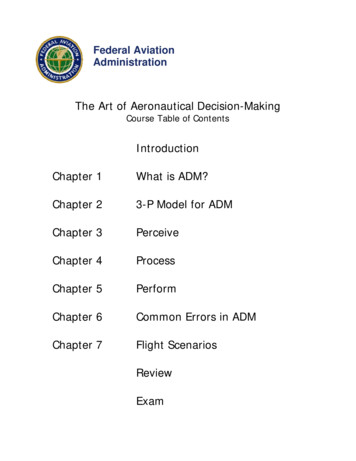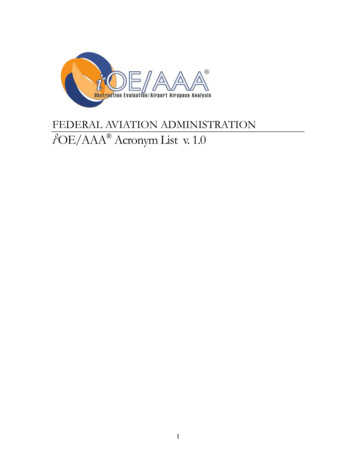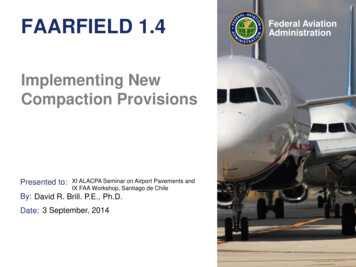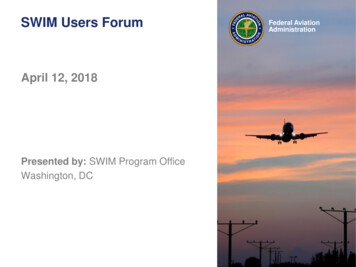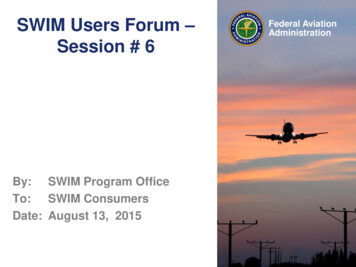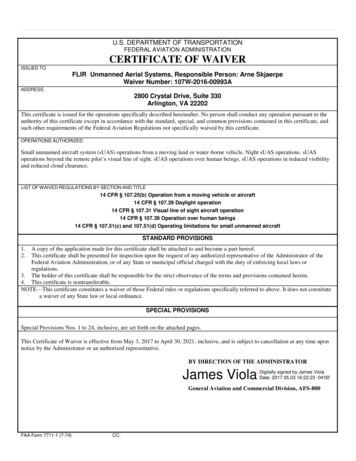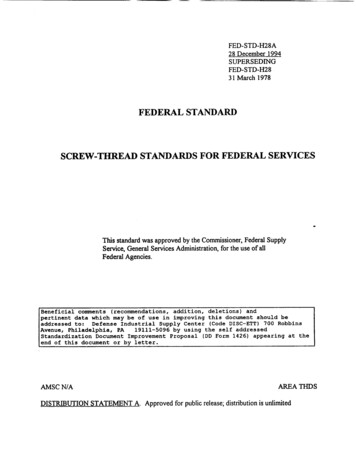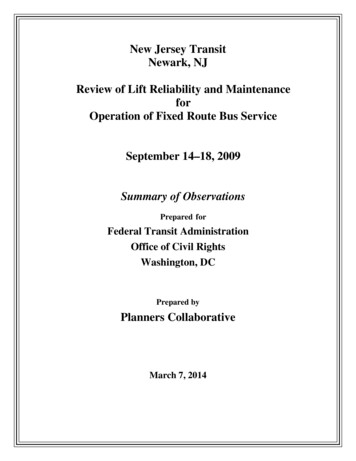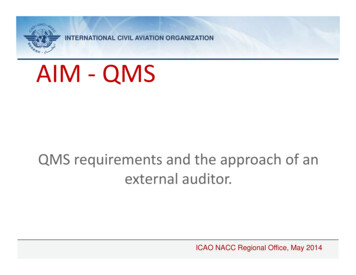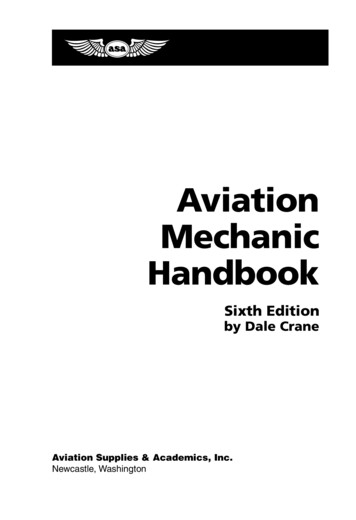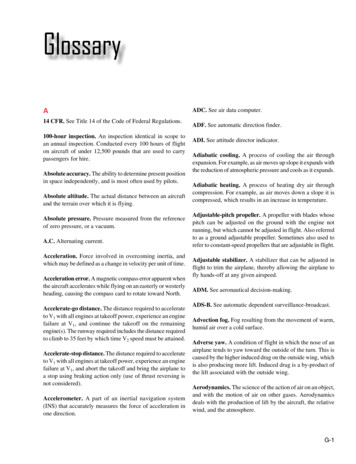
Transcription
GlossaryA14 CFR. See Title 14 of the Code of Federal Regulations.100-hour inspection. An inspection identical in scope toan annual inspection. Conducted every 100 hours of flighton aircraft of under 12,500 pounds that are used to carrypassengers for hire.Absolute accuracy. The ability to determine present positionin space independently, and is most often used by pilots.Absolute altitude. The actual distance between an aircraftand the terrain over which it is flying.Absolute pressure. Pressure measured from the referenceof zero pressure, or a vacuum.A.C. Alternating current.Acceleration. Force involved in overcoming inertia, andwhich may be defined as a change in velocity per unit of time.Acceleration error. A magnetic compass error apparent whenthe aircraft accelerates while flying on an easterly or westerlyheading, causing the compass card to rotate toward North.Accelerate-go distance. The distance required to accelerateto V1 with all engines at takeoff power, experience an enginefailure at V1, and continue the takeoff on the remainingengine(s). The runway required includes the distance requiredto climb to 35 feet by which time V2 speed must be attained.Accelerate-stop distance. The distance required to accelerateto V1 with all engines at takeoff power, experience an enginefailure at V1, and abort the takeoff and bring the airplane toa stop using braking action only (use of thrust reversing isnot considered).Accelerometer. A part of an inertial navigation system(INS) that accurately measures the force of acceleration inone direction.ADC. See air data computer.ADF. See automatic direction finder.ADI. See attitude director indicator.Adiabatic cooling. A process of cooling the air throughexpansion. For example, as air moves up slope it expands withthe reduction of atmospheric pressure and cools as it expands.Adiabatic heating. A process of heating dry air throughcompression. For example, as air moves down a slope it iscompressed, which results in an increase in temperature.Adjustable-pitch propeller. A propeller with blades whosepitch can be adjusted on the ground with the engine notrunning, but which cannot be adjusted in flight. Also referredto as a ground adjustable propeller. Sometimes also used torefer to constant-speed propellers that are adjustable in flight.Adjustable stabilizer. A stabilizer that can be adjusted inflight to trim the airplane, thereby allowing the airplane tofly hands-off at any given airspeed.ADM. See aeronautical decision-making.ADS-B. See automatic dependent surveillance-broadcast.Advection fog. Fog resulting from the movement of warm,humid air over a cold surface.Adverse yaw. A condition of flight in which the nose of anairplane tends to yaw toward the outside of the turn. This iscaused by the higher induced drag on the outside wing, whichis also producing more lift. Induced drag is a by-product ofthe lift associated with the outside wing.Aerodynamics. The science of the action of air on an object,and with the motion of air on other gases. Aerodynamicsdeals with the production of lift by the aircraft, the relativewind, and the atmosphere.G-1
Aeronautical chart. A map used in air navigation containingall or part of the following: topographic features, hazards andobstructions, navigation aids, navigation routes, designatedairspace, and airports.Aeronautical decision-making (ADM). A systematicapproach to the mental process used by pilots to consistentlydetermine the best course of action in response to a givenset of circumstances.Agonic line. An irregular imaginary line across the surface ofthe Earth along which the magnetic and geographic poles arein alignment, and along which there is no magnetic variation.Ailerons. Primary flight control surfaces mounted on thetrailing edge of an airplane wing, near the tip. Ailerons controlroll about the longitudinal axis.Aircraft. A device that is used, or intended to be used, forflight.Aircraft altitude. The actual height above sea level at whichthe aircraft is flying.Aircraft approach category. A performance grouping ofaircraft based on a speed of 1.3 times the stall speed in thelanding configuration at maximum gross landing weight.Air data computer (ADC). An aircraft computer thatreceives and processes pitot pressure, static pressure, andtemperature to calculate very precise altitude, indicatedairspeed, true airspeed, and air temperature.Airfoil. Any surface, such as a wing, propeller, rudder, oreven a trim tab, which provides aerodynamic force when itinteracts with a moving stream of air.Air mass. An extensive body of air having fairly uniformproperties of temperature and moisture.AIRMET. Inflight weather advisory issued as an amendmentto the area forecast, concerning weather phenomena ofoperational interest to all aircraft and that is potentiallyhazardous to aircraft with limited capability due to lack ofequipment, instrumentation, or pilot qualifications.Airplane. An engine-driven, fixed-wing aircraft heavier thanair that is supported in flight by the dynamic reaction of airagainst its wings.Airplane Flight Manual (AFM). A document developedby the airplane manufacturer and approved by the FederalAviation Administration (FAA). It is specific to a particularmake and model airplane by serial number and it containsoperating procedures and limitations.Airplane Owner/Information Manual. A documentdeveloped by the airplane manufacturer containing generalinformation about the make and model of an airplane. Theairplane owner’s manual is not FAA approved and is notspecific to a particular serial numbered airplane. This manualis not kept current, and therefore cannot be substituted forthe AFM/POH.Airport diagram. The section of an instrument approachprocedure chart that shows a detailed diagram of theairport. This diagram includes surface features and airportconfiguration information.Airport/Facility Directory (A/FD). See Chart SupplementU.S.Airport surface detection equipment (ASDE). Radarequipment specifically designed to detect all principalfeatures and traffic on the surface of an airport, presenting theentire image on the control tower console; used to augmentvisual observation by tower personnel of aircraft and/orvehicular movements on runways and taxiways.Airport surveillance radar (ASR). Approach controlradar used to detect and display an aircraft’s position in theterminal area.Airport surveillance radar approach. An instrumentapproach in which ATC issues instructions for pilotcompliance based on aircraft position in relation to the finalapproach course and the distance from the end of the runwayas displayed on the controller’s radar scope.Air route surveillance radar (ARSR). Air route trafficcontrol center (ARTCC) radar used primarily to detectand display an aircraft’s position while en route betweenterminal areas.Air route traffic control center (ARTCC). Provides ATCservice to aircraft operating on IFR flight plans withincontrolled airspace and principally during the en route phaseof flight.Airspeed. Rate of the aircraft’s progress through the air.G-2
Airspeed indicator. A differential pressure gauge thatmeasures the dynamic pressure of the air through which theaircraft is flying. Displays the craft’s airspeed, typically inknots, to the pilot.Alternate static source valve. A valve in the instrument staticair system that supplies reference air pressure to the altimeter,airspeed indicator, and vertical speed indicator if the normalstatic pickup should become clogged or iced over.Air traffic control radar beacon system (ATCRBS).Sometimes called secondary surveillance radar (SSR), whichutilizes a transponder in the aircraft. The ground equipment isan interrogating unit, in which the beacon antenna is mountedso it rotates with the surveillance antenna. The interrogatingunit transmits a coded pulse sequence that actuates the aircrafttransponder. The transponder answers the coded sequenceby transmitting a preselected coded sequence back to theground equipment, providing a strong return signal andpositive aircraft identification, as well as other special data.Altimeter. A flight instrument that indicates altitude bysensing pressure changes.Airway. An airway is based on a centerline that extends fromone navigation aid or intersection to another navigation aid(or through several navigation aids or intersections); usedto establish a known route for en route procedures betweenterminal areas.Ambient pressure. The pressure in the area immediatelysurrounding the aircraft.Airworthiness Certificate. A certificate issued by the FAAto all aircraft that have been proven to meet the minimumstandards set down by the Code of Federal Regulations.AME. See aviation medical examiner.Airworthiness Directive. A regulatory notice sent out bythe FAA to the registered owner of an aircraft informingthe owner of a condition that prevents the aircraft fromcontinuing to meet its conditions for airworthiness.Airworthiness Directives (AD notes) are to be complied withwithin the required time limit, and the fact of compliance,the date of compliance, and the method of compliance arerecorded in the aircraft’s maintenance records.Alert area. An area in which there is a high volume of pilottraining or an unusual type of aeronautical activity.Almanac data. Information the global positioning system(GPS) receiver can obtain from one satellite which describesthe approximate orbital positioning of all satellites in theconstellation. This information is necessary for the GPSreceiver to know what satellites to look for in the sky at agiven time.ALS. See approach lighting system.Alternate airport. An airport designated in an IFR flightplan, providing a suitable destination if a landing at theintended airport becomes inadvisable.Altimeter setting. Station pressure (the barometric pressureat the location the reading is taken) which has been correctedfor the height of the station above sea level.Altitude engine. A reciprocating aircraft engine having arated takeoff power that is producible from sea level to anestablished higher altitude.Ambient temperature. The temperature in the areaimmediately surrounding the aircraft.Amendment status. The circulation date and revisionnumber of an instrument approach procedure, printed abovethe procedure identification.Ammeter. An instrument installed in series with an electricalload used to measure the amount of current flowing throughthe load.Aneroid. The sensitive component in an altimeter orbarometer that measures the absolute pressure of the air.It is a sealed, flat capsule made of thin disks of corrugatedmetal soldered together and evacuated by pumping all ofthe air out of it.Aneroid barometer. An instrument that measures theabsolute pressure of the atmosphere by balancing the weightof the air above it against the spring action of the aneroid.Angle of attack. The angle of attack is the angle at whichrelative wind meets an airfoil. It is the angle that is formedby the chord of the airfoil and the direction of the relativewind or between the chord line and the flight path. Theangle of attack changes during a flight as the pilot changesthe direction of the aircraft and is related to the amount oflift being produced.G-3
Angle of incidence. The acute angle formed between thechord line of an airfoil and the longitudinal axis of the aircrafton which it is mounted.Anhedral. A downward slant from root to tip of an aircraft’swing or horizontal tail surface.Annual inspection. A complete inspection of an aircraft andengine, required by the Code of Federal Regulations, to beaccomplished every 12 calendar months on all certificatedaircraft. Only an A&P technician holding an InspectionAuthorization can conduct an annual inspection.Asymmetric thrust. Also known as P-factor. A tendency foran aircraft to yaw to the left due to the descending propellerblade on the right producing more thrust than the ascendingblade on the left. This occurs when the aircraft’s longitudinalaxis is in a climbing attitude in relation to the relative wind.The P-factor would be to the right if the aircraft had acounterclockwise rotating propeller.ATC. Air Traffic Control.ATCRBS. See air traffic control radar beacon system.ATIS. See automatic terminal information service.Anti-ice. Preventing the accumulation of ice on an aircraftstructure via a system designed for that purpose.Antiservo tab. An adjustable tab attached to the trailing edgeof a stabilator that moves in the same direction as the primarycontrol. It is used to make the stabilator less sensitive.Approach lighting system (ALS). Provides lights that willpenetrate the atmosphere far enough from touchdown togive directional, distance, and glidepath information for safetransition from instrument to visual flight.Area chart. Part of the low-altitude en route chart series,this chart furnishes terminal data at a larger scale forcongested areas.Area forecast (FA). A report that gives a picture of clouds,general weather conditions, and visual meteorologicalconditions (VMC) expected over a large area encompassingseveral states.Area navigation (RNAV). Allows a pilot to fly a selectedcourse to a predetermined point without the need to overflyground-based navigation facilities, by using waypoints.Arm. See moment arm.ARSR. See air route surveillance radar.ARTCC. See air route traffic control center.Atmospheric propagation delay. A bending of theelectromagnetic (EM) wave from the satellite that createsan error in the GPS system.Attitude. A personal motivational predisposition to respondto persons, situations, or events in a given manner that can,nevertheless, be changed or modified through training as sortof a mental shortcut to decision-making.Attitude and heading reference system (AHRS). A systemcomposed of three-axis sensors that provide heading, attitude,and yaw information for aircraft. AHRS are designed toreplace traditional mechanical gyroscopic flight instrumentsand provide superior reliability and accuracy.Attitude director indicator (ADI). An aircr
See aviation medical examiner. Amendment status. The circulation date and revision number of an instrument approach procedure, printed above the procedure identification. Ammeter. An instrument installed in series with an electrical load used to measure the amount of current flowing through the load. Aneroid. The sensitive component in an altimeter or barometer that measures the absolute .File Size: 365KBPage Count: 36

